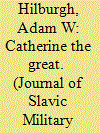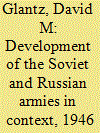| Srl | Item |
| 1 |
ID:
132462


|
|
|
|
|
| Publication |
2014.
|
| Summary/Abstract |
The campaigns of Catherine the Great against the Ottoman Empire in the 1770s reveal key characteristics of operational art. Catherine's campaigns serve as an example of lesser-known conflicts that fulfill the necessary conditions of the numerous schools of thought on operational art. The operational commander, Rumiantsev, developed an operational plan to meet the strategic directives developed by Catherine's permanent 'Council attached to the Court'. His armies used successive tactical actions to engage Turkish maneuver forces and lay siege to its fortresses. The armies were organized into combined arms corps that coordinated to remain mutually supporting with the ability to concentrate at the decisive point when required and the Russian armies to not fight in the linear methods of its Western counterparts. Additionally, the armies and corps conducted distributed operations throughout the theater of war, at times hundreds of kilometers separating them. More importantly, Rumiantsev arranged tactical actions to achieve strategic objectives, the most important part of the definition of operational art. These successive, distributed operations should satisfy the schools of thought that consider Napoleon's campaigns as operational art, but those that understand operational art beginning with Grant and Moltke may see that the Russian Campaigns on the frontiers also move beyond the classical strategy of a single point
|
|
|
|
|
|
|
|
|
|
|
|
|
|
|
|
| 2 |
ID:
096035


|
|
|
|
|
| Publication |
2010.
|
| Summary/Abstract |
This chronological and topical outline describes the institutional and doctrinal evolution of the Soviet and Russian Armies from 1946 through 2009 within the broad context of vital political, economic, and social developments and a wide range of important international and national occurrences. Its intent is to foster further informed discussion of the subject. Each of the article's sub-sections portrays military developments in the Soviet or Russian Armies during one of the eight postwar periods Soviet and Russian military scholars, themselves, routinely identify as distinct stages in the development and evolution of their Armed Forces. Each of the periods, argue Russian commentators, is distinguishable by a wide range of characteristics, both internal and external, that prove unique to each period.
|
|
|
|
|
|
|
|
|
|
|
|
|
|
|
|